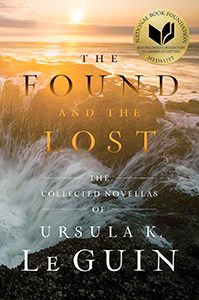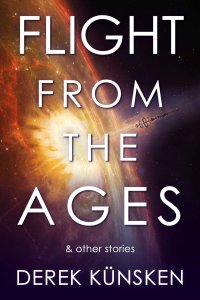Paul Di Filippo Reviews Ursula K. Le Guin
The Found and the Lost: The Collected Novellas of Ursula K. Le Guin, Ursula K. Le Guin (Saga Press 978-1-4814-5208-3, $29.99, 804pp, hc) October 2016.
 How can a reviewer possibly say something fresh and illuminating about a writer of Ursula K. Le Guin’s immense stature, at this epochal moment in her career? Among all but the most newly minted readers of fantastika, her name should be a well-known byword for quality, and the classic titles that earned her her sparkling reputation will trip lightly and enthusiastically off the tongue. Mainstream readers know her as well, thanks to appearances in The New Yorker and other literary journals, as well perhaps from the Earthsea television miniseries. She has Grandmaster status from SFWA, and a new volume from the Library of America (The Complete Orsinia: Malafrena / Stories and Songs), earning herself the double distinction of being 1) a living author in the Library of America’s predominantly historical catalogue and 2) an author of fantastika amongst their predominantly mimetic honor roll. Even to any possible detractors (yes, there are some; most notably, a generation back, renegade critic Charles Platt), her canon will be a given, not needing any explication.
How can a reviewer possibly say something fresh and illuminating about a writer of Ursula K. Le Guin’s immense stature, at this epochal moment in her career? Among all but the most newly minted readers of fantastika, her name should be a well-known byword for quality, and the classic titles that earned her her sparkling reputation will trip lightly and enthusiastically off the tongue. Mainstream readers know her as well, thanks to appearances in The New Yorker and other literary journals, as well perhaps from the Earthsea television miniseries. She has Grandmaster status from SFWA, and a new volume from the Library of America (The Complete Orsinia: Malafrena / Stories and Songs), earning herself the double distinction of being 1) a living author in the Library of America’s predominantly historical catalogue and 2) an author of fantastika amongst their predominantly mimetic honor roll. Even to any possible detractors (yes, there are some; most notably, a generation back, renegade critic Charles Platt), her canon will be a given, not needing any explication.
So the reviewer is left, I think, with the task of pointing out favored themes and tropes and techniques which might appear only retrospectively, at this late stage of a career, and also just reminding the audience of the exact nature of the writer’s achievements. Luckily, two new mammoth collections from Saga Press allow us to do just that. Today, however, we will only be looking at one. Because Le Guin has had a fair number of prior short-story volumes, the first offering from Saga, The Unreal and the Real: The Selected Short Stories of Ursula K. Le Guin, contains lots of very well-known items found in other venues. The second book, however, while still featuring a couple of famous tales, represents the first time her novellas have been assembled together.
Thirteen entries, arranged by date of publication, total some 800 pages, representing an extensive spectrum of narratives. It’s hard to imagine getting more value for your hard-earned book-buying dollars.
“Vaster than Empires and More Slow” strikes me as Le Guin’s foray into Tiptree territory, along the lines of “A Momentary Taste of Being”. A cast of neurotic misfits (not unallied to the schitzy protagonists of many a PKD novel, reminding us of Le Guin’s long-standing resonance with her old high-school chum) are sent as explorers to a world which features only vegetable life. The likelihood of such an ecology is made believable, freeing us to focus on the dynamics among the crew and the alien mind they discover. Readers of Robert Silverberg’s early pulp adventures will note a familiar template updated for the 1960s. This tale fits into the Hainish Cycle that characterized Le Guin’s early years of writing, as do many of the other novellas here, proving that a good future history can last for decades, receiving upgrades as its creator matures.
An immediate change of pace and tone arrives with “Buffalo Gals, Won’t You Come Out Tonight”. Here Le Guin is in superb magical-realist mode as she describes the fate of a young girl crash-landed in the American Southwest who finds herself adopted by the traditional earthy inhabitants of that region’s Native American mythos. A kind of Tarzan vibe underpins the sometimes scary, sometimes gross, sometimes funny exploits of the child in a strange land.
I admired the construction and ambition of the tale titled “Hernes” more than I actually relished reading it. It is a multigenerational saga told in hopscotch chronology, concerning several women mostly resident in the Pacific Northwest. Its evocation of several eras is miraculous in its palpability, and the sorrowful plight of the generally abused yet resilient protagonists, echoing down the years with twists and lateral displacements, is affecting. But the repetitiveness of the conflicts began to seem too much at this long length. The closing lines evoke a kind of Thomas Wolfe existential melancholy. “Who is it that lights the light? Whose child are you, who is your child? Whose story will be told?”
We begin to see what might be regarded as one of the quintessential Le Guin concerns—male-female relationships and how they contour society and are contoured in return—in “The Matter of Seggri”. On a planet where women outnumber men by sixteen-to-one, culture and customs have evolved accordingly. Le Guin’s famous flair for “deep anthropology” is on display, making this Vancian tale a fascinating hybrid of document and narrative.
Deep emotional chords are plucked in “Another Story or a Fisherman of the Inland Sea”. Our hero grows up in a somewhat backwoods environment, goes off to more sophisticated realms with some losses and regret, and then—well, I won’t spoil the surprise of his ultimate physics-inflected fate.
Lurking in the middle of this book is a novel in four parts. “Forgiveness Day”, “A Man of the People”, “A Woman’s Liberation”, and “Old Music and the Slave Women” all take place on the planet Werel, where an elite class owns other humans dubbed “assets.” This sequence starts with the extant system firmly in place, then moves through revolt and reconstruction. The first tale follows the exploits of the Ekumen’s representative to Werel, an ultra-competent woman named Solly, who lives through the turbulence and chaos of the violent paradigm shift. The POV in the second tale is a Hainish man named Havzhiva, who charts a path from his primitive origins to the heights of Ekumen service. “I was born a slave on the planet Werel.” That is the starting point for the third installment, which shows the gradual enlightenment of one of the former “assets.” And finally we return to riding the shoulders of an Ekumen representative, Old Music, who undergoes wartime excruciations along the lines of Solly’s, which bring new self-knowledge and understandings of the others whom he lives among.
The next three stories represent a welcome and astonishing return to Le Guin’s beloved realm of Earthsea, where quotidian yet fabulist matters receive the unique gravitas of Le Guin’s comprehension of the links between magical powers and human responsibilities and ambitions. “The Finder” shows us the long life and many transformations of the boy who begins as “Otter” and who swaps identities twice more, changing deeply along the way. His talent for intuiting the location of valuable objects places him in peril as much as it rewards. A beaten, seemingly derelict fellow arrives in cow country in “On the High Marsh”. He manifests a humble ability to cure cattle of their ills. But beneath his shambolic façade lurks a certain majesty. Finally, the young woman who gives her name to the story “Dragonfly” dares to breach the all-male wizard school on Roke, bringing illuminations to the faculty and herself.
The final entry here is “Paradises Lost”, which is a deft instantiation of the classic “power chord” of generation starship, and which falls somewhere between Gene Wolfe and Robert Heinlein in tone and conceptualization. As always, Le Guin shows herself most interested in the interplay between genders and amongst the different strata of society. Exactly how is culture transmitted from parents to children?
What one takes away from this collection is both an esthetic lesson and a lesson in the misapprehension of a writer’s legacy.
The first appreciation derives from the sheer level of talent and word-wizardry and world-building that Le Guin exhibits. These stories are constructed so solidly, with such ingenuity and craftsmanship and heart, that they achieve the inevitable rightness and impressiveness of real world things. The reader closes this book fully acknowledging Le Guin’s Grandmaster stature.
The second appreciation derives from how multivalent and non-dogmatic and fair-minded and actually nonpartisan Le Guin and her fiction are. In this current genre climate of superheated argumentativeness and reductionist zealotry from both sides of the fence, Le Guin is often cast as some kind of party president endorsing a progressive platform whose simplistic tenets are carved in stone. Nothing in her fiction actually promotes this. When, for instance, in “The Matter of Seggri”, she shows how the minority men have all the privilege while the majority women have all the power, and that such an arrangement is just as unfair and unproductive as the reverse, we note the kind of playful, experimental, what-if mindset so alien to more ideologically slanted fiction, but which a true speculator must possess.
And consider this passage from “Dragonfly.”
The one with a voice like a deep-toned bell looked at her too, and spoke to her with a plain, kind severity. “As I see it, the man who brought you here meant to do harm, but you do not. Yet being here, Irian, you do us and yourself harm. Everything not in its own place does harm. A note sung, however well sung, wrecks the tune it isn’t part of. Women teach women. Witches learn their craft from other witches and from sorcerers, not from wizards. What we teach here is in a language not for women’s tongues. The young heart rebels against such laws, calling them unjust, arbitrary. But they are true laws, founded not on what we want, but on what is. The just and the unjust, the foolish and the wise, all must obey them, or waste life and come to grief.”
This is not delivered ironically, or as the words of a bigot. It’s the truth as the wizards of Roke see things—as Le Guin sees things. One might almost call it a “conservative” stance, in the most honorable and ancient interpretation of that label. Quite a shock to those who would hold the author up as an unmitigated revolutionary.
We learn in “The Finder” that “The danger in trying to do good is that the mind comes to confuse the intent of goodness with the act of doing things well.” It’s a lesson all creators especially must take to heart, and which Le Guin exemplifies most nobly.






That interpretation of “Irian” is so wrong.
Passage you quote is, in the story, a lie or at least fallacy.
The whole meaning of the story is to break that lie.
Women and men are equal, women can learn, etc. etc.